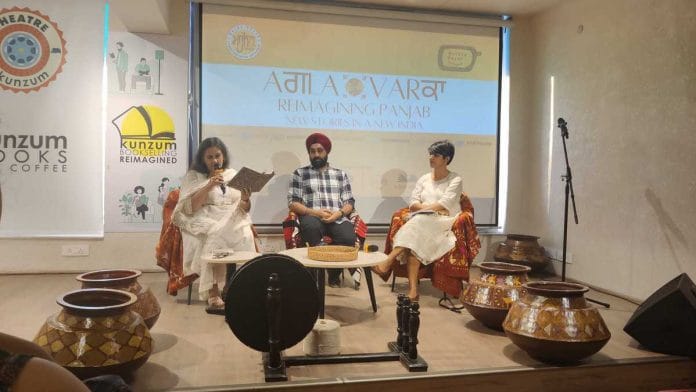New Delhi: Several eyes grew moist as author Sanam Sutirath Wazir shared the heart-wrenching experiences of Sikh women from his book, The Kaurs of 1984, at an event last week. To capture the darkest chapter of their lives, Wazir spent a decade conducting 457 interviews across Punjab, Kanpur, and Delhi.
For many of these women, survivors of the anti-Sikh riots, grief and loss were compounded by hostility and silencing. Wazir recounted how one woman described the dual burden of sorrow and social ostracism she endured as a Sikh widow.
“A woman suffers when her husband dies, but many of these (women) were declared the wives of traitors overnight in 1984. Things became worse for them. It was difficult to step out of houses, visit government offices and workplaces,” said Wazir.
At Delhi’s Theatre Kunzum, where Wazir was in conversation with academic and historian Kanika Singh and author Amrita Bhalla, the atmosphere grew tense as he described the horrific experiences of a woman who lost her husband and was repeatedly gang-raped during the riots.
“She shared with me how she requested her mother to not leave her alone while she was being gangraped. Her mother waited for her,” said Wazir, adding that such conversations were never easy.
The event, conducted by the cultural platform Agla Varka explored ‘Panjab’s women: Stories of resistance, resilience, and protest beyond victimhood’. For Wazir, simply sharing these stories was an important step forward, especially given the silence surrounding sexual assault.
One survivor, he said, bluntly explained this silence: “Parents were worried about their daughters getting married. So, they preferred to never talk about it.”
The panellists also touched upon a more general reluctance to discuss 1984 among Sikhs. Historian Singh noted that for a long time people were not allowed to talk about 1984.
“Often the voices of minorities are linked to separatism,” added Wazir.
Also Read: ‘My helpless mother stood watching me being raped’—A Kaur recalls 1984 anti-Sikh violence
Aftermath of 1984
The anti-Sikh riots in Delhi were a three-day frenzy of violence, halting only when the Army intervened. But author Amrita Bhalla, who lived through its horrors, pointed out how the effects are still felt decades later.
Bhalla shared an incident from 1997 when she and her turbaned Sikh husband were speeding on a Delhi road. A traffic police officer stopped them and warned them how unsafe it was to make any mistake, his words carrying a quiet menace.
“He said, ‘You can be arrested for speeding Sardar ji and god never knows what next’,” Bhalla recalled.
Many Sikhs, especially the younger generation, migrated overseas after the riots, she pointed out.
“It was not only the loss of life and property… the riots broke the families as well,” Bhalla added.
When Bhalla asked about “closure” for the victims, Wazir shared how he asked the same question to many in Tilak Nagar, infamously known as ‘Widows Colony’.
“All of them have one common answer—’It is not about forgetting or forgiving, acknowledgement is what we sought. Had someone acknowledged our loss, things would have got easier’,” said Wazir.
In an emotional moment, Bhalla recited lines from a poignant poem by the Punjabi writer and poet Amrita Pritam. The poem is addressed to the Sufi bard Waris Shah, who wrote ‘Heer-Ranjha’. It references the horrors of Partition but also resonates with the suffering during the 1984 riots.
It says: Ik royi si dhee Punjab di tu likh likh maare vain; Aj lakhaan dheeyan rondiyan tenu Waris Shah nu kehn (You once wrote a wailing saga when a daughter of Punjab cried; Today, a million daughters, cry to you, Waris Shah).
Also Read: A new documentary restarts the old debate on 1984 violence. Genocide, riots, pogrom?
‘Women continue to suffer’
For many survivors, money and memorials are no panacea for the wounds of 1984.
“There are three generations who have faced the aftermath of the incident. Mere compensation cannot be the way out to start afresh,” Wazir said.
The author also narrated the story of Satwant Kaur, who fought her in-laws for compensation after her husband’s death.
“This woman suffered at the hands of her in-laws. She struggled for money,” Wazir added. And when she tried to make money, her social conditioning haunted her.
For some time, Satwant Kaur sang for a living, performing at hotels and parties. But she was often required to wear bright clothes.
Wazir quoted her: “It was due to clothes that I had to leave my job because I thought that my dead husband would get offended because of the bright colours.”
The book details Satwant’s arduous life post the riots, including a spell of homelessness and always feeling like a burden. Despite financial aid and employment, the trauma of witnessing violence, living in relief camps, and forced displacement made fully healing impossible.
“The uncomfortable truth is that a majority of the survivors still feel devastated,” Wazir writes.
The gendered burden was even greater.
“Women are the first casualty in every conflict and continue to suffer. They live with the pain every day, every moment they talk about it. The cycle of trauma continues,” Wazir said at the event.
Singh stressed the limited memorialisation of Sikh history, especially the 1984 massacre. She noted that it was only in 2017 that a Sikh genocide memorial was built at Gurudwara Rakab Ganj Sahib by the Delhi Gurudwara Management Committee.
“Many Sikh women victims of 1984 do not associate themselves with the memorials much, especially the one at Tilak Nagar because they refuse to accept that they are the wives of martyrs. They say their husbands were killed (rather than dying for a cause),” added Singh.
(Edited by Asavari Singh)






